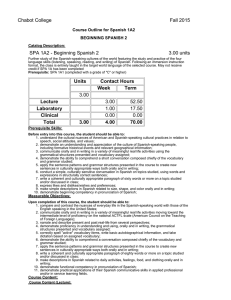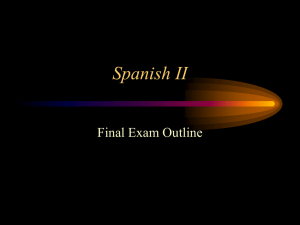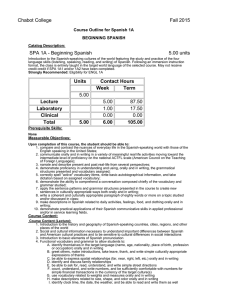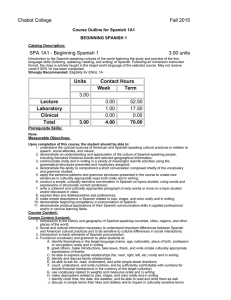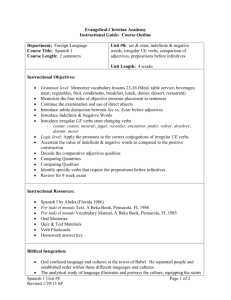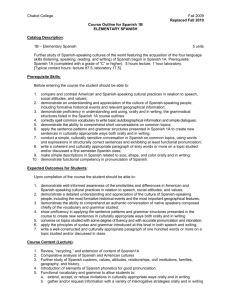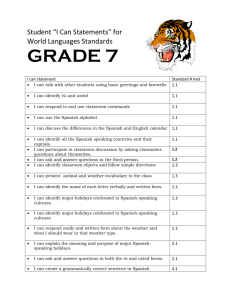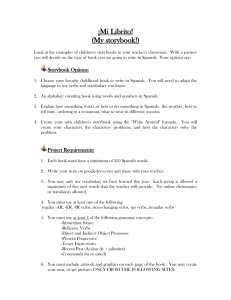Beginning Spanish
advertisement
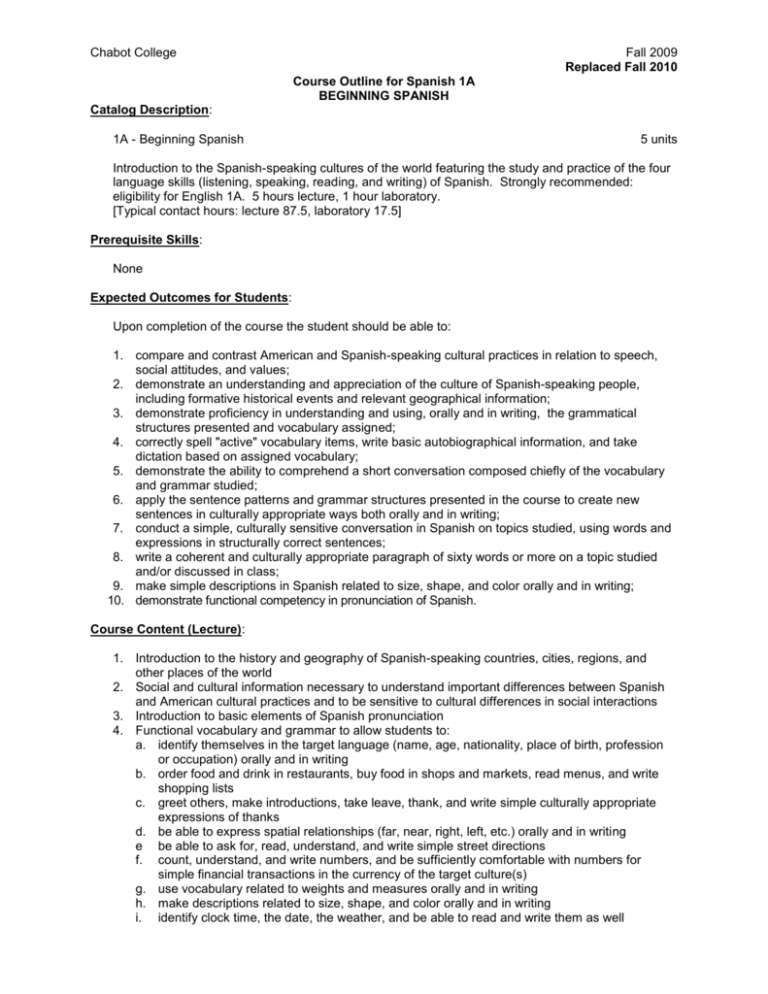
Chabot College Fall 2009 Replaced Fall 2010 Course Outline for Spanish 1A BEGINNING SPANISH Catalog Description: 1A - Beginning Spanish 5 units Introduction to the Spanish-speaking cultures of the world featuring the study and practice of the four language skills (listening, speaking, reading, and writing) of Spanish. Strongly recommended: eligibility for English 1A. 5 hours lecture, 1 hour laboratory. [Typical contact hours: lecture 87.5, laboratory 17.5] Prerequisite Skills: None Expected Outcomes for Students: Upon completion of the course the student should be able to: 1. compare and contrast American and Spanish-speaking cultural practices in relation to speech, social attitudes, and values; 2. demonstrate an understanding and appreciation of the culture of Spanish-speaking people, including formative historical events and relevant geographical information; 3. demonstrate proficiency in understanding and using, orally and in writing, the grammatical structures presented and vocabulary assigned; 4. correctly spell "active" vocabulary items, write basic autobiographical information, and take dictation based on assigned vocabulary; 5. demonstrate the ability to comprehend a short conversation composed chiefly of the vocabulary and grammar studied; 6. apply the sentence patterns and grammar structures presented in the course to create new sentences in culturally appropriate ways both orally and in writing; 7. conduct a simple, culturally sensitive conversation in Spanish on topics studied, using words and expressions in structurally correct sentences; 8. write a coherent and culturally appropriate paragraph of sixty words or more on a topic studied and/or discussed in class; 9. make simple descriptions in Spanish related to size, shape, and color orally and in writing; 10. demonstrate functional competency in pronunciation of Spanish. Course Content (Lecture): 1. Introduction to the history and geography of Spanish-speaking countries, cities, regions, and other places of the world 2. Social and cultural information necessary to understand important differences between Spanish and American cultural practices and to be sensitive to cultural differences in social interactions 3. Introduction to basic elements of Spanish pronunciation 4. Functional vocabulary and grammar to allow students to: a. identify themselves in the target language (name, age, nationality, place of birth, profession or occupation) orally and in writing b. order food and drink in restaurants, buy food in shops and markets, read menus, and write shopping lists c. greet others, make introductions, take leave, thank, and write simple culturally appropriate expressions of thanks d. be able to express spatial relationships (far, near, right, left, etc.) orally and in writing e be able to ask for, read, understand, and write simple street directions f. count, understand, and write numbers, and be sufficiently comfortable with numbers for simple financial transactions in the currency of the target culture(s) g. use vocabulary related to weights and measures orally and in writing h. make descriptions related to size, shape, and color orally and in writing i. identify clock time, the date, the weather, and be able to read and write them as well Chabot College Course Outline for Spanish 1A, Page 2 Fall 2009 j. discuss in simple terms their likes and dislikes and to inquire in culturally sensitive terms into likes and dislikes of others, orally and in writing k. function successfully in basic cultural interactions that involve buying tickets and requesting and paying for services (public transportation, taxis, post offices, hotels) 5. Syntax and grammar that allows students to correctly use orally and in writing: a. subject pronouns, direct and indirect object pronouns b. present indicative (regular verbs and verbs with irregular yo forms) and present progressive verbs c. preterit tense (regular verbs; ir, ser, dar, hacer; time expressions including hace . . . que + preterit), irregular verbs, and stem-changing verbs d. the imperfect tense; the preterit and the imperfect e. using verbs in the negative; using affirmative and negative words f. regular and irregular verbs (including ser, tener, ir, estar, saber, conocer, dar, and hacer) g. reflexive verbs h. gender and number of nouns and adjectives i. possessive de and possessive adjectives j. position of adjectives k. demonstrative adjectives and pronouns l. para and por to indicate purpose, destination, duration, and other uses m. prepositions and prepositional pronouns n. adverbs ending in –mente o. ya and todavía p. hace + time expression + verb in the present q. using past participles as adjectives r. iba a + infinitive and tenía/tuve que + infinitive to express past actions s. saber and conocer in the imperfect and preterit Course Content (Laboratory): 1. Activate lecture content using interactive audio and audiovisual programs on CDs, DVDs, CD ROMS, target language websites, etc., featuring culturally authentic and contextual guided speaking, reading, and writing activities such as cued repetition of native speech, dictations, cued oral responses, listening comprehension, and interactive realia (culturally authentic texts). 2. Organized laboratory activities including conversation groups. 3. Fundamentals of Spanish pronunciation: a. Stressing words b. Similarity of stressed and unstressed vowels c. The two pronunciations of the consonant d d. Unaspirated p, t, and k e. The consonants r and rr f. The consonant ñ g. The consonants ll and y h. The sound /g/ i. The sound /k/ j. The consonants b and v Methods of Presentation: 1. 2. 3. 4. Lecture/discussion in target language Choral/individual repetition of model speech Re-creation of dialogues and improvisation Small group activities leading to skits, dialogues, etc. curriculum 0809 dk 11/12/08 Chabot College Course Outline for Spanish 1A, Page 3 Fall 2009 Assignments and Methods of Evaluating Student Progress: 1. Typical Assignments a. Demonstrate "ordering" skills in a restaurant skit. b. Demonstrate aural understanding of street directions by tracing examples of such directions on a map. c. Laboratory Assignment: After studying stress in Spanish pronunciation, make a recording of the poem “Machu Picchu” by Pablo Neruda. d. Write a paragraph that includes basic biographical information, such as nationality, place of birth, birthday, and current residence. 2. Methods of Evaluating Student Progress a. Tests, quizzes, and interviews to evaluate the four language skills in relation to material presented b. Student participation in class activities c. Homework assignments d. Recordings from the language laboratory to evaluate pronunciation skills e. Final examination Textbook(s) Typical: Claro que sí: An Integrated Skills Approach, Lucia Caycedo, Debbie Rusch, and Marcela Domínguez, sixth edition, Houghton Mifflin (Boston and New York) 2008. Claro que sí: An Integrated Skills Approach, Workbook and Laboratory Manual, sixth edition, Houghton Mifflin (Boston and New York) 2008. Special Student Materials: None curriculum 0809 dk 11/12/08
